- Home
- Jared Diamond
The Third Chimpanzee: The Evolution and Future of the Human Animal
The Third Chimpanzee: The Evolution and Future of the Human Animal Read online
A SEVEN STORIES PRESS FIRST EDITION
Copyright © 2014 by Jared Diamond
All rights reserved.
No part of this book may be reproduced, stored in a retrieval system, or transmitted in any form or by any means, including mechanical, electric, photocopying, recording, or otherwise, without the prior written permission of the publisher.
SEVEN STORIES PRESS
140 Watts Street
New York, NY 10013
www.sevenstories.com
College professors may order examination copies of Seven Stories Press titles for free. To order, visit www.sevenstories.com/ textbook or send a fax on school letterhead to (212) 226-1411.
A teaching guide and lesson plan for The Third Chimpanzee for Young People, as well as other select titles within the Young People’s series from Triangle Square / Seven Stories Press, is available for free download at www.sevenstories.com.
Book design by Pollen/Stewart Cauley, New York
Library of Congress Cataloging-in-Publication Data Stefoff, Rebecca, 1951-
Third chimpanzee for young people / by Jared Diamond ; adapted by Rebecca Stefoff. -- Seven Stories Press first edition.
pages cm
Adapted from Jared M. Diamond’s The third chimpanzee.
Includes index.
ISBN 978-1-60980-522-7
1. Human evolution--Juvenile literature. 2. Social evolution- juvenile literature. 3. Nature--Effect of human beings on-Juvenile literature. I. Diamond, Jared M. II. Diamond, Jared M. Third chimpanzee. III. Title.
GN281.S785 2014
573.2--dc23
2013040205
Printed in the United States
9 8 7 6 5 4 3 2 1
Contents
Introduction
WHAT MAKES US HUMAN?
PART ONE
JUST ANOTHER BIG MAMMAL
CHAPTER 1: A TALE OF THREE CHIMPS
CHAPTER 2: THE GREAT LEAP FORWARD
PART TWO
A STRANGE LIFE CYCLE
CHAPTER 3: HUMAN SEXUALITY
CHAPTER 4: THE ORIGIN OF HUMAN RACES
CHAPTER 5: WHY DO WE GROW OLD AND DIE?
PART THREE
UNIQUELY HUMAN
CHAPTER 6: THE MYSTERY OF LANGUAGE
CHAPTER 7: ANIMAL ORIGINS OF ART
CHAPTER 8: AGRICULTURE, FOR BETTER AND WORSE
CHAPTER 9: WHY DO WE SMOKE, DRINK, AND USE DANGEROUS DRUGS?
CHAPTER 1O: ALONE IN A CROWDED UNIVERSE
PART FOUR
WORLD CONQUERORS
CHAPTER 11: THE LAST FIRST CONTACTS
CHAPTER 12: ACCIDENTAL CONQUERORS
CHAPTER 13: IN BLACK AND WHITE
PART FIVE
REVERSING OUR PROGRESS OVERNIGHT
CHAPTER 14: THE GOLDEN AGE THAT NEVER WAS
CHAPTER 15: BLITZKRIEG AND
THANKSGIVING IN THE NEW WORLD
CHAPTER 16: THE SECOND CLOUD
Afterword
NOTHING LEARNED, EVERYTHING FORGOTTEN?
Glossary
Photograph and Illustration Credits
About the Authors
Introduction
WHAT MAKES US HUMAN?
HUMANS ARE DIFFERENT FROM ALL ANIMALS.
At the same time, humans are animals—a species of big mammal. This contradiction is our most fascinating feature. We still have a hard time understanding what it means and how it came to be.
On one hand, between us and all other species lies a gulf that leads us to call them “animals” and to see them as separate from us. We think that centipedes, chimpanzees, and clams share some animal features that we don’t have, or that we have human features that they don’t share. Those human features include communicating through language, enjoying art, making complex tools, wearing clothes, and darker traits such as killing mass numbers of our own and other species.
On the other hand, we have the same body parts, molecules, and genes as other animals. It’s even clear what type of animal we are. As long ago as the eighteenth century, scientists who studied anatomy (the structure of the body) saw that humans are very similar to chimpanzees, animals that live in Africa. We recognize two species of chimpanzees: the common chimp and the bonobo, sometimes called the pygmy chimp. A scientist from outer space would immediately classify humans as a third species of chimpanzee. Scientists right here on Earth know that we share more than 98 percent of our genetic makeup with the other two chimps.
The difference between our genes and chimps’ genes is small. Yet that small difference must have been responsible for the things that make humans unique. And all those changes happened fairly recently in our genetic history. Somehow, within a few tens of thousands of years, we started to show the features that make humans unique and fragile. This book takes a close look at how and why we developed those features, both good and bad—from language, art, and our life cycle to our ability to destroy our own and other species.
How This Book Came to Be
My own interests and background shaped this book. As a child, I wanted to be a doctor. By my last year in college, that goal had gently changed, and I wanted to become a medical researcher. I trained in physiology, which is the study of how living systems function, from cells to animals. Afterward I went on to teach and do research at the University of California Medical School in Los Angeles.
But I had other interests as well. Birdwatching had attracted me since the age of seven, and I had also been lucky to attend a school that let me plunge into languages and history. I did not like the idea of spending the rest of my life on physiology alone. Then I had the chance to spend a summer in the highlands of New Guinea, a large tropical island north of Australia. The purpose of the trip was to measure how successfully birds were nesting. That project collapsed when I was unable to locate even a single bird’s nest in the jungle, but the trip fed my thirst for adventure and birdwatching in one of the wildest remaining parts of the world.
After that first trip to New Guinea, I developed a second career, focused on birds, evolution, and biogeography. I’ve returned to New Guinea and the neighboring Pacific islands many times to pursue my bird research. As I saw human activity destroying the forests and birds I loved, I became involved in conservation, helping governments design national parks to protect ecosystems and plant and animal species.
Finally, it was hard to study the evolution and extinction of birds without wanting to understand the evolution and possible extinction of the most interesting species of all, the species that includes you, me, and everyone on Earth—Homo sapiens, the modern human. This book was the result. It begins with a look at our origins several million years ago. It ends with some thoughts about our future, and about ways we can learn from our past.
Building a Big Picture
The story of how we became human spans millions of years, and it pulls together information and ideas from many branches of science. In writing this book, I drew on my own experiences and the sciences I have studied, and also on the work of many scientists in other fields, from archaeology to zoology. Pieces of the story come from fields as different as paleopathology, the study of ancient diseases, and paleobotany, the science of fossil plants.
As you’ve seen, my background started with anatomy and physiology, then moved on to the study of birds, especially their ecology—that is, the ways bird interact with other species around them and with their environment. As a biogeographer, I’m interested in the relationships between geography and living things. Biogeographers ask questions such as: Why are some species spread out across almost the entire world
, while others live only in a single tree? As you’ll see in this book, biogeography has played a big role in the history of our species.
I am also an evolutionary biologist. This means that I look at animals and plants in terms of evolution, the process of change in life on Earth over time, as new species develop and old ones become extinct. (In chapter 4, you’ll read about how this happens.) In this book, I use the framework of evolutionary biology to examine human features and behavior.
Seeing Ourselves in a New Way
From a scientist’s point of view, things often look different from the way they look in everyday life. Take the question of how people are attracted to each other. What do you find attractive in another person? There are as many answers to that question as there are individuals in the world.
But to an evolutionary biologist, the question takes on another dimension. Because we see the human species as part of the natural world, we assume that people are shaped by the same forces that shape other species. By looking for patterns in the way birds and mice and apes choose their mates, as I do in chapter 3, we expect to learn something about our own behavior.
In evolutionary terms, successful features and behaviors let parents produce the greatest number of children, who will eventually produce children of their own, passing the parents’ genes on to new generations. This doesn’t mean that evolutionary biology is the complete explanation, or the only explanation, for everything people do. It does mean that seeing ourselves as part of the evolutionary history of life enlarges our knowledge.
Looking at our own species in the same way we look at others can bring new understanding of human behavior that may seem confusing or mysterious, or make us uncomfortable. It is a way of knowing ourselves better—and the quest for selfknowledge is a very human characteristic.
PART ONE
JUST ANOTHER BIG MAMMAL
(Left to right: Gibbon, Human, Chimpanzee, Gorilla, Orangutan.) Five members of the primate family: Homo sapiens and four kinds of apes. The similar anatomy of human and ape skeletons had been recognized for centuries, but DNA studies confirmed that chimpanzees are our closest relatives, and we are theirs.
WHEN, WHY, AND HOW DID WE STOP BEING JUST another species of big mammal? Clues come from three types of evidence, all explored in the next two chapters. Fossil bones and preserved tools are traditional evidence from archaeology, the study of the past through physical remains. A newer kind of evidence comes from the science of molecular biology, which examines our genetic heritage and traces our descent from an apelike ancestor.
One basic question concerns the differences between us and chimpanzees. Just looking at humans and chimps and counting visible differences doesn’t help, because many genetic changes have effects that can’t be seen, while other changes have very obvious effects. A Great Dane and a Chihuahua look much more different from each other than a chimp and a human being do. Yet all dogs belong to the same species, but chimps and humans are different species.
So how can we tell our genetic distance from chimps? The problem has been solved by molecular biologists. They have discovered that the gene difference between us and chimps is greater than the difference between any two living human populations or any two breeds of dogs. But the gene difference between us and chimps is small compared with differences between many other pairs of related species. This means that only a small change in the chimpanzee genes led to enormous changes in humans’ behavior.
Next we’ll consider what we can learn from the bones and tools left by creatures along the way between our apelike ancestor and modern humans. Fossil bones show the switch from our walking on all fours to walking upright, and our increase in brain size. Our large brain was surely necessary for the development of human language and inventiveness. In fact, we might expect the fossil record to show our tools getting better as our brains got bigger. But the greatest surprise and puzzle of human evolution is that stone tools remained very crude for hundreds of thousands of years after our brains had expanded almost to their present size.
Sixty thousand years ago, Neanderthals had brains even larger than those of modern humans, yet their tools show no signs of inventiveness or art. Neanderthals were still just another species of big mammal. Even for tens of thousands of years after some other human populations had evolved skeletons like those of modern people, their tools remained as boring as Neanderthals’ tools.
Within the small percentage of difference between our genes and chimpanzee genes, there must have been an even smaller percentage that was not involved in the shapes of our bones but that gave us the human traits of inventiveness, artistic creativity, and the use of complex tools. In Europe, at least, those traits appeared suddenly at the time Neanderthals were replaced by the early modern humans known as Cro-Magnons. That’s when we finally stopped being just another species of big mammal. At the end of part 1, I’ll talk about what triggered our steep rise to human status.
CHAPTER I
A TALE OF THREE CHIMPS
THE NEXT TIME YOU VISIT A ZOO, WALK PAST THE ape cages. Imagine that the apes had lost most of their hair and that next to them was a cage holding some unfortunate people who had lost their clothes and couldn’t speak but were normal in every other way. Now try guessing how different the apes’ genes are from the humans’ genes. Would you guess that a chimpanzee shares 10 percent, 50 percent, or 99 percent of its genetic makeup with humans?
In recent decades, science has answered that question. Even though many other questions remain unanswered, we now know more about our origins than ever before. Every human society has felt a deep need to make sense of its origins, and has met that need with its own story of creation. The creation story of our time is the tale of three chimps.
Three Questions
For centuries it’s been clear roughly where we fit into the animal kingdom. We are mammals, part of the group of animals that have hair and nurse their young. Among mammals, we are primates, the group of mammals that includes monkeys and apes. We share primate features that most non-primates do not have, including flat fingernails and toenails (rather than claws), hands for gripping, and thumbs that can move in the opposite direction from our fingers.
Within the primates, we are more similar to apes (gorillas, chimpanzees, orangutans, and gibbons) than to monkeys. For one thing, monkeys have tails, but apes and humans do not. Gibbons stand out from the other apes because they are small and have very long arms. Gorillas, chimpanzees, orangutans, and humans are more closely related to one another than any of them is to gibbons.
Going further into our primate relationships proved difficult for scientists. It led to an intense debate centered on three questions:
* What is the detailed family tree of relationships among humans, the living ape species, and the extinct ape species that were our ancestors? If we knew the answer to this question, we would know which living ape is our closest relative.
* When did we and our closest living relative last share the same ancestor? This would tell us how long ago the human line branched off the family tree.
* How much of our genetic makeup do we share with our closest living relative? This would tell us what percentage of our genes is uniquely human.
Fossil evidence might answer the first two questions, except for one unfortunate fact. Almost no ape fossils have been found for the crucial period between five and fourteen million years ago in Africa. Instead, the answers to the questions came from an unexpected source: a project to sort out relationships among bird species.
A Clue from the Bird World
In the 1960s, molecular biologists began to realize that the chemicals that make up plants and animals might provide “clocks” to measure the genetic distances between species, and to tell how long ago those species separated from each other on the evolutionary tree. Take lions and tigers, for example.
Suppose we knew from fossils that lions and tigers separated five million years ago. Suppose that a certain molecule in lions was 1 percent different f
rom the same molecule in tigers. That would mean that 1 percent of genetic difference equaled five million years of separate evolution. Then, if scientists wanted to compare two living species but had no fossils to show those species’ evolutionary history, they could look at that same molecule in both species. If the difference between the two molecules was 3 percent, they would know that the species separated from their shared ancestor about fifteen million years ago—that is, three times five million.
In the 1970s, two scientists named Charles Sibley and Jon Ahlquist used the idea of a molecular clock based on changes in DNA to study the evolutionary relationships of about 1,700 bird species, nearly a fifth of all living birds. A decade later, they used the same techniques to study primate evolution. For this project they examined the DNA of humans and all our closest relatives: common chimpanzees, bonobos (or pygmy chimpanzees), gorillas, orangutans, two species of gibbons, and seven species of monkeys. Their results gave us a new understanding of the primate family tree.
A CLOCK MADE OF DNA
THE MOLECULAR CLOCK WORKS THIS WAY:
Suppose some type of molecule existed in all species, but had a unique structure in each species. Suppose that structure changed slowly over millions of years because of genetic mutations, and suppose the rate of change was the same for all species.
Two species that descended from the same ancestor would start off with identical forms of the molecule, inherited from their ancestor. Over time, though, mutations would occur independently in each line of descent. These mutations would change the structure of that molecule in each of the two species. We could measure the present difference in the molecule’s structure between the two. Then, if we knew how many structural changes occurred, on average, every million years, the present difference between the two species would serve as a “clock,” telling us how much time had passed since the two species shared a common ancestor.
By around 1970, molecular biologists had found that the best “clock” molecule is deoxyribonucleic acid, or DNA. It occurs in all living things but is unique to each species. DNA is made up of two long chains of molecules.

 Why Is Sex Fun?: The Evolution of Human Sexuality
Why Is Sex Fun?: The Evolution of Human Sexuality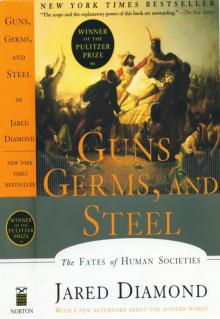 Guns, Germs, and Steel: The Fates of Human Societies
Guns, Germs, and Steel: The Fates of Human Societies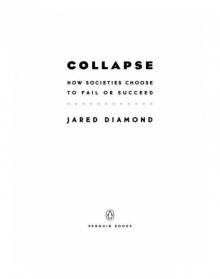 Collapse: How Societies Choose to Fail or Succeed
Collapse: How Societies Choose to Fail or Succeed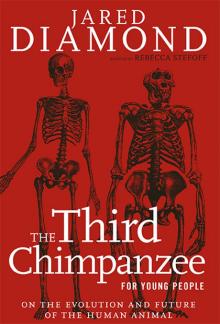 The Third Chimpanzee: The Evolution and Future of the Human Animal
The Third Chimpanzee: The Evolution and Future of the Human Animal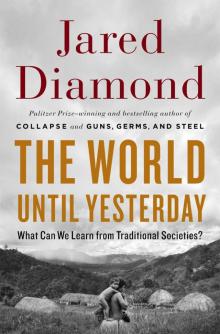 The World Until Yesterday: What Can We Learn From Traditional Societies?
The World Until Yesterday: What Can We Learn From Traditional Societies?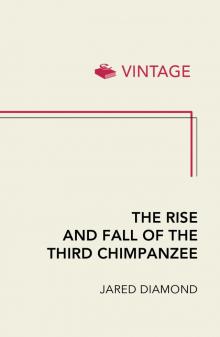 The Rise and Fall of the Third Chimpanzee
The Rise and Fall of the Third Chimpanzee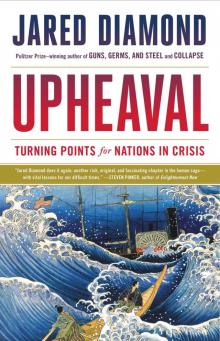 Upheaval: Turning Points for Nations in Crisis
Upheaval: Turning Points for Nations in Crisis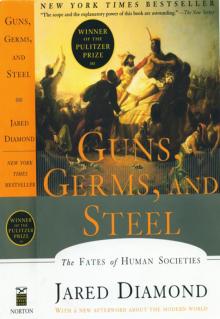 Guns, Germs, and Steel
Guns, Germs, and Steel The Third Chimpanzee for Young People
The Third Chimpanzee for Young People Why Is Sex Fun?
Why Is Sex Fun?